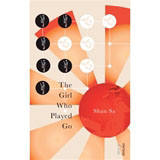Judging books by their covers

To grab the readers’ attention, publishers are putting more effort than ever into cover design and creating distinctive looks, says Sarah Balmond
Long gone are the days when books were displayed in shops spine-side only. It’s more likely now that publications are stacked high up alongside each other, jigsawed together on centrally placed tables, the books hustling for your attention with eye-grabbing covers of all kinds, ranging from the abstract through to the illustrative. Jacket design has always been of consideration, but a book’s look is now more important than ever as publishers integrate design into long-term marketing plans in a bid to create instant shelf stand-out and expand readership.
Roger Cazalet, group marketing director at Little, Brown Book Group, has been in the publishing industry for about 15 years. He believes that book jacket design has become steadily more upmarket as increasingly sophisticated designs are applied to even the mass-market genres, such as crime.
A book’s design has always been closely aligned to a marketing strategy. ‘You have to look at the design and question if this is pushing the right buttons. How will it look on consumer ads? Is it sending out the right message? How does it fit in with the look of other writers?’ explains Cazalet.
In efforts to reach a wider readership, authors and imprint series are habitually relaunched with fresh iconic looks. Since buying the rights to Nicholas Evans, author of The Horse Whisperer, Little, Brown is poised to relaunch his series of four books with a more contemporary look, says Cazalet.
The publisher has also been working with Unreal to create a different image for thriller writer Michael Robotham. The graphic-led identity is rolling out across his portfolio of books, including The Night Ferry, a title due to launch this autumn. The design features a more ‘in your face, quite hard, type with a sinister icon referencing an element from the book,’ explains Unreal creative director, Brian Eagle.

In general, book cover design is vital in helping to establish and develop an author’s career, says Cazalet. ‘You must create a distinctive own-niche look, which should be refreshed every three-to-five years. If a book is dull-looking, it won’t be picked up. Consumers have more sophisticated tastes now and books have to catch up with this or they will sink. In general, the crime set moves together with small, subtle shifts in the design, but always with a distinctive look. You can’t stray too far without alienating your core readers,’ says Cazalet.
Competitor Random House also strives to roll out creative book cover designs in a bid to stay one step ahead. It recently launched a limited edition series under its Vintage imprint, re-jacketing nine books written by Japanese and Chinese authors with a more illustrative, subtle design.
The Vintage East collection features a red, black and soft grey colour palette with a simple graphic drawn on the cover to suggest the separate themes of each book. A red circle, designed to represent the symbol of the Eastern sun, is given a different illustrative treatment for each title, with the author’s name placed inside. The project was overseen by Random House creative director Suzanne Dean.
‘We wanted to reinvent these titles with a new, consistent look. The marketing team were very behind us. It is important to work together to create the whole package for the book,’ says Dean.
She says the boundaries of book design are being pushed with the proliferation of increasingly experimental and adventurous jacket cover designs. ‘Currently, there is a shift back to illustrative-led designs. At one point, there was so much photography on book covers. At the moment, there is experimentation with book sizes, materials and printing techniques. The book cover plays such an important role; it is what you see first,’ she says.
Random House recently published a series of quirky covers for The Bedroom Secrets of the Master Chefs by Irvine Welsh. The design features tongue-in-cheek phallic graphics, sure to catch the roving consumer eye (DW 3 August). The three book covers were designed to be stacked alongside each other to form a single display, implicitly demonstrating how marketing can be manipulated into a thought-provoking, original design. The technique of aligning designs end-to-end in-store is used on pack by many fmcg brands.

However, Jonathan Ellery, partner at Browns Design, questions how innovative book cover design has become. He warns against the influence of marketing. ‘I don’t see any major changes happening in book cover design. Most book covers still tend to be mediocre, driven by so-called market forces. Generally, the marketing departments of the major publishing houses take on a misguided creative directorship role, therefore guaranteeing a continued missed opportunity,’ he says.
It seems inevitable that so long as the consumer continues to judge a book by its cover, the design will continue to evolve, however radical it may be.
Book Facts:
• Total book sales of UK publishers in 2005: £2.8bn
• There are about 60 000 active publishers in the UK and Ireland
• About 1.6m titles are available for sale in the UK
• Consumers aged 12 to 74 spent an estimated £2396m on books in 2005, up 8 per cent from 2004
• For further statistics, see The Publishers Association’s website, www.publishers.org.uk
-
Post a comment




